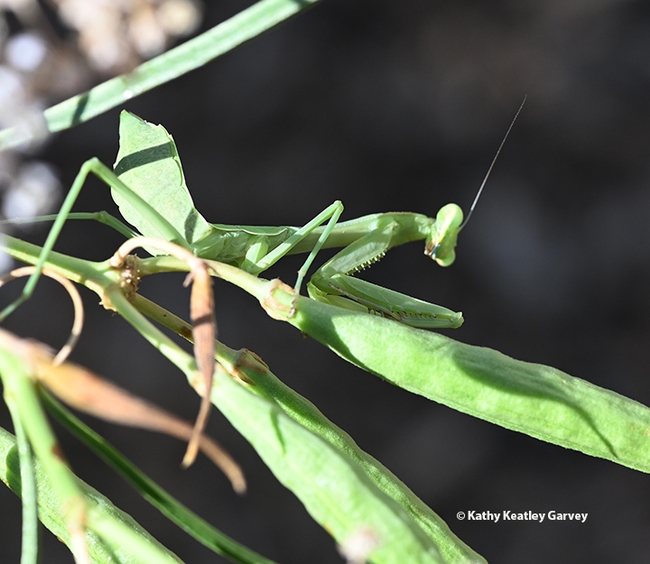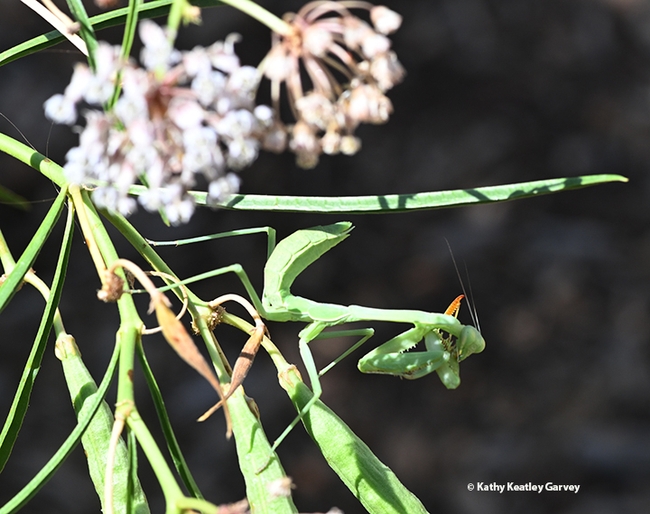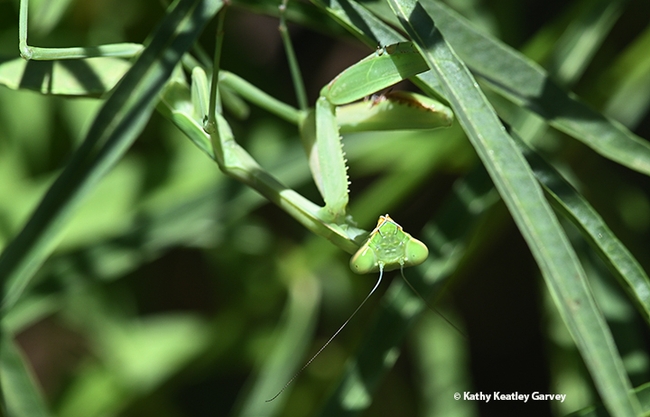- Author: Kathy Keatley Garvey
So here's this immature praying mantis, a Stagmomantis limbata, perched on a narrow-leafed milkweed, Asclepias fascicularis, in a Vacaville pollinator garden.
She's camouflaged quite well. She's as green and thin as the leaves.
Me: "Hey, Ms. Mantis, whatcha doin'?"
Ms. Mantis: "Just occupying a spot on this milkweed. Catching some sun, is all."
Me: "Hoping to catch a monarch, Ms. Mantis?"
Ms. Mantis: "No, no, of course not. I would never, ever, catch a monarch! You know me!"
Me: "I do know you. Promise you won't nail a monarch?"
Ms. Mantis: "Sorry, I can't promise if I'm hungry. Now, go away, you're disrupting my choice of menu items."
Me: "How about a stink bug or a lygus bug?"
Ms. Mantis: "I don't take menu orders. What do you think I am? DoorDash? Go away!"
Me: "Hey, I see a katydid nymph over there!"
Ms. Mantis: "Where, where? How far?"
Me: (Pointing to a lower leaf) "Over there!"
With that, Ms. Mantis slipped off the blossom, never to be seen again.
Epilogue: The California scrub jays noisily nesting in the cherry laurel hedges may have snagged a Stagmomantis mantis meal.
They don't take orders, either.
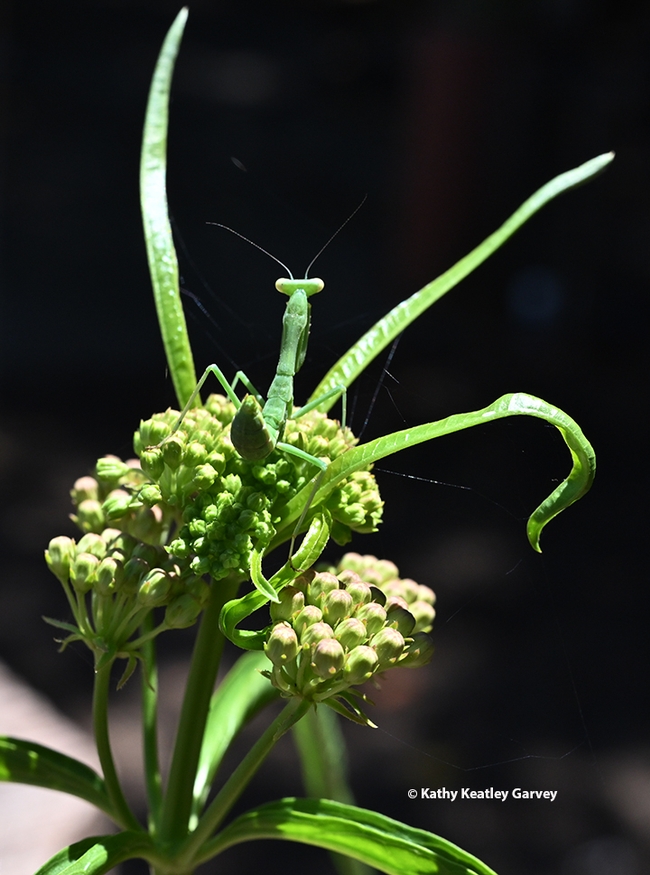
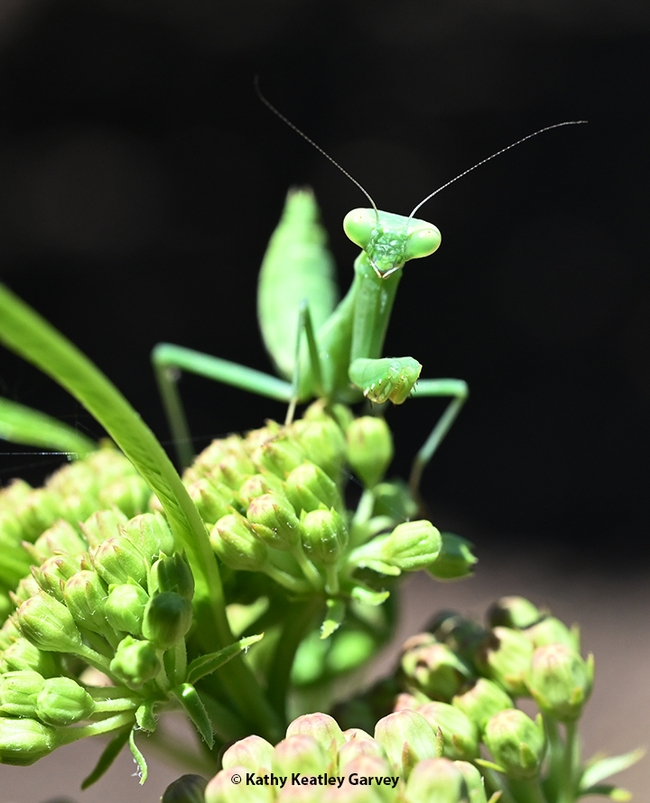
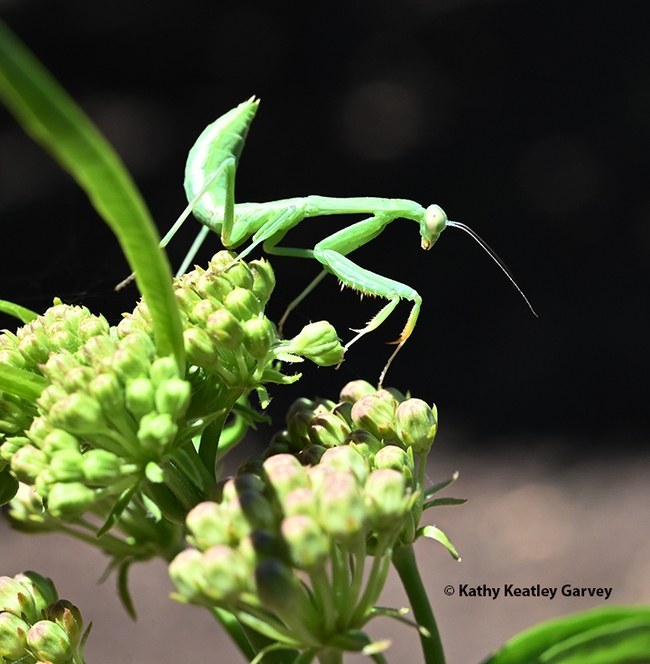
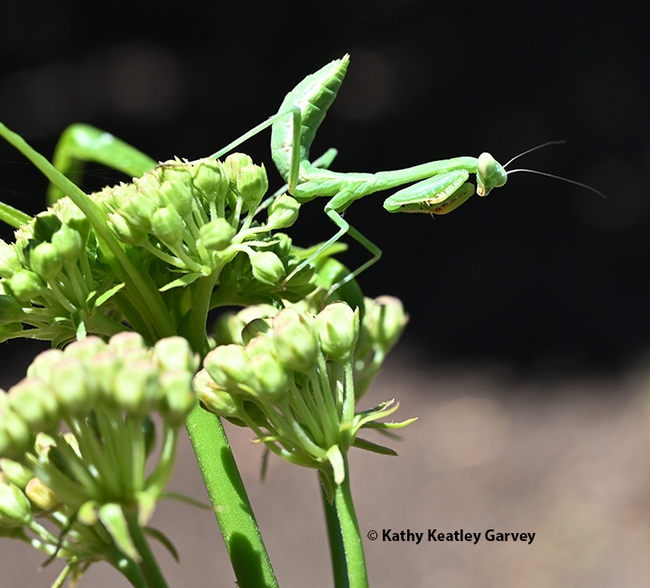
- Author: Kathy Keatley Garvey

In stunning images, the Bohart Museum display depicts the complete metamorphosis of the monarch: from egg to larva to pupa to adult.
It's the work of Larry Snyder of Davis, who for several years photographed a UC Davis professor's research project on wild monarch-native milkweed interactions in the North Davis Channel of rural Davis. Snyder is a retired music teacher, vocal accompanist, and piano and harpsichord technician.
We wrote about the monarch-milkweed project on the UC Davis Department of Entomology and Nematology website on July 28, 2022.
Professor Louie Yang, the principal investigator of the research project, organized and led a 135-member team, all co-authors of the paper, “Different Factors Limit Early- and Late-Season Windows of Opportunity for Monarch Development,” published in the journal Ecology and Evolution. (This document is open access at https://bit.ly/3volFaI.)
From 2015 through 2017, the team monitored the interactions of monarchs, Danaus plexippus, on narrow-leafed milkweed, Asclepias fascicularis, planted in December 2013 on city-owned property adjacent to the North Davis irrigation channel.
The project, funded by two of Yang's National Science Foundation grants, involved UC Davis, Davis Senior High School and the Center for Land-Based learning. Among them were 107 high school students and a K-12 teacher, 18 UC Davis undergraduate students, three graduate students and two post-graduate researchers.
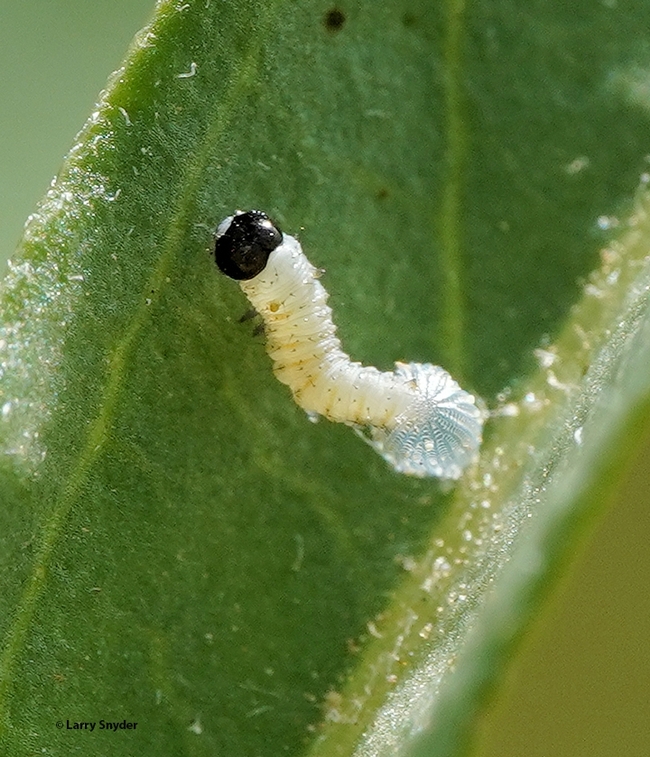
Unfortunately, a City of Davis maintenance crew unintentionally mowed the site on May 5, 2017, “damaging several plants in this population," Yang related. "However, most plants in the population were below the height of the mower blades at this point in the growing season.”
Today the milkweed population at the North Davis Channel is being maintained by the City of Davis and dedicated citizens, including Larry Snyder.
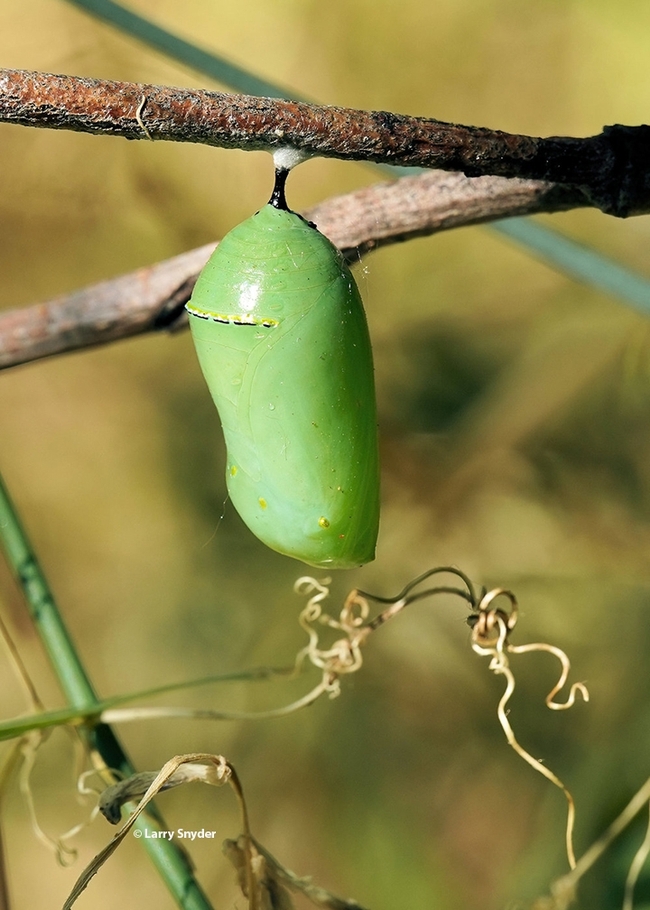
From music to milkweed to monarchs...it's been quite a journey.
The work of Professor Yang's MMMILC crew fascinated him, and the site became his "adopted back yard." At first, Snyder just watched, then he began photographing "the insect life on the plants." At the end of the project's official monitoring period, he "secured the cooperation of city staff" so he could continue maintaining the milkweeds without the loss of spring growth to the annual fire-suppression mowings.
Snyder says he "especially enjoys watching insect behavior and interaction, both within and between species and in relation to the host plants, as well as tracking how individual populations change during the seasons and from year to year."
"I am most grateful to the Bohart Museum and the frequent assistance of their remarkable staff and associates," Snyder said.
The Bohart Museum, founded in 1946, is directed by Lynn Kimsey, UC Davis distinguished professor of entomology. It is the global home of eight million insect specimens, as well as the live "petting zoo" and an insect-themed gift shop stocked with t-shirts, hoodies, books, posters, jewelry, collecting equipment and more. Named for UC Davis professor and noted entomologist Richard Bohart, it is open to the public from 8 a.m. to noon, and 1 to 5 p.m., Mondays through Thursdays. More information is available on the website at https://bohart.ucdavis.edu or by contacting bmuseum@ucdavis.edu.
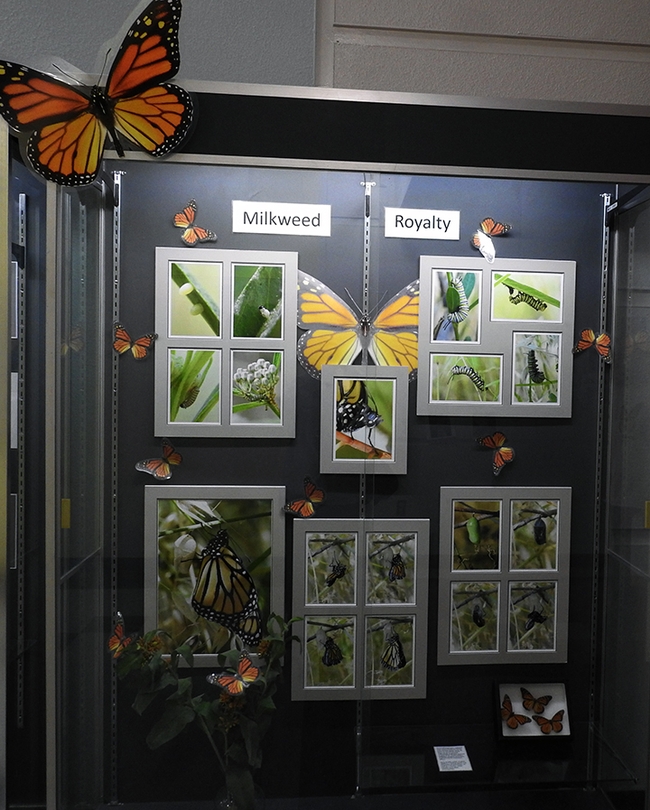
- Author: Kathy Keatley Garvey

On Friday, Aug. 26, he met with success. He spotted four within half an hour.
It all began with his stroll through the UC Davis Arboretum and Public Garden, "where construction at Wyatt Deck was finally completed and the paths have been reopened," he related in a group email.
"It was my first time there in about 3 weeks. As usual, I scoped out the big Asclepias speciosa clone and found...nothing." He then crossed over Arboretum Drive to the Environmental Horticultural gardens where he knew of another small clone of A. speciosa. "By now it was 4:30 p.m. and the area was in dappled light and shade--and there were two brilliantly fresh-looking male monarchs chasing each other in the trees above the milkweed!"
"I looked over the plants for evidence of larval feeding and found absolutely none; I can't believe they were 'born' there despite being so brilliantly fresh-looking. I then walked west on Arboretum Drive, intending to turn north toward Mrak Hall, when an old, worn male monarch flew directly in front of me near eye level. It was now 4:50.
"As I went to turn toward Mrak (Hall) a fresh-looking one--sex undetermined--was cruising up in the trees near the bridge. I believe I saw four different individuals within half an hour. That's almost as many as I've seen in Davis all year."
Then, on Aug. 29, Shapiro ventured to north Davis where Professor Louie Yang of the UC Davis Department of Entomology and Nematology and collaborators had planted several dozen narrow-leaf milkweed, Asclepias fascicularis, several years ago for their research projects. "Nearly all the plants are in seed; I only found three still in bloom," Shapiro said. "And one had a beautiful, fresh-looking male monarch nectaring at it at 11.55 a.m. I didn't try inspecting all those plants but on casual inspection, I noted no evidence of larval feeding, nor pupae nor pupal exuviae."
That's good news on The Monarch Front.
Shapiro's colleague and former doctoral student Matt Forister, the McMinn Professor of Biology at the University of Nevada, Reno (UNR), alerted him to more good monarch news: "They're passing through Reno with increasing frequency. I am personally seeing ~1 per day now. All stopping for nectar, and heading your way, Art. Looks like the production in the desert has been good." (See latest research by Forister and colleagues on "Milkweed Plants Bought at Nurseries May Expose Monarch Caterpillars to Harmful Pesticide Residues," published in the science journal Biological Conservation.)
As you may know, Shapiro has been studying the butterfly populations at 10 sites in Central California for 50 years and maintains a research website, Art Shapiro's Butterfly Site, aka Art's Butterfly World.
The North American Butterfly Monitoring Network (NABA) website praises his work as "the longest continually running butterfly monitoring project in the world":
"Art Shapiro began monitoring 10 transects in 1972 and has been conducting bi-weekly monitoring of those sites ever since. He also monitors an additional site as part of NABA's Seasonal Count Program! Art's program is the longest continually running butterfly monitoring project in the world, predating even the British Butterfly Monitoring Scheme."
Elsewhere in Davis, Bohart Museum of Entomology associate Greg Kareofelas has seen monarchs in his Davis backyard three times this year: May 6, May 11, and in early June. "A couple of days ago, in the Inner Coast Range, Glenn county I saw nine or ten adults and that many larvae."
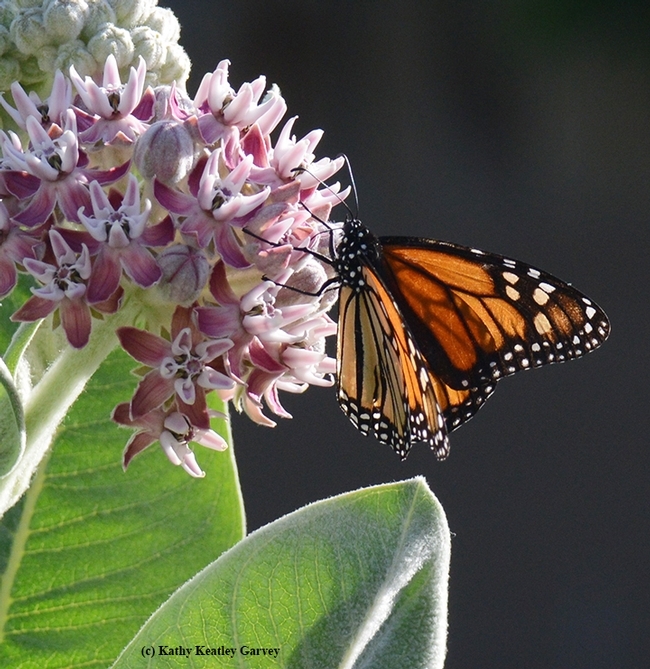

- Author: Kathy Keatley Garvey
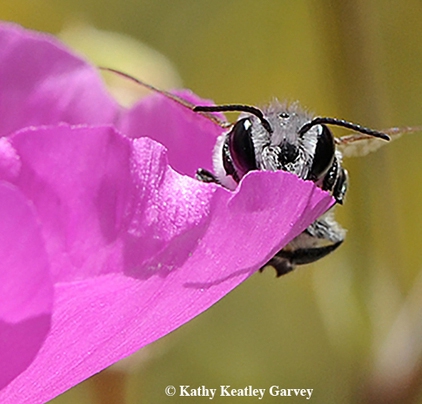
The narrowleafed milkweed, Asclepias fascicularis, beckons monarch butterflies (the host plant), aphids, praying mantids and assorted other insects, but once in a while, you'll see a leafcutter bee. Both the plant and the bee are natives.
This male bee (below) spent the afternoon patrolling for females, but it rested in between.
It's a dangerous place to rest when there's a predator (praying mantis) around, but all ended well.
Leafcutter bees, spp., so named because the females cut leaves and petals (perfectly round holes!) to line their nests, are smaller than honey bees--and much faster. They're easily recognizable by the black-white bands on their abdomen.
The females do all the work. They gather pollen and nectar, make the nests from the leaf and petal fragments, and lay eggs. They seal the egg chambers with the leaves or flower petals.
The male's job is to reproduce. And sometimes, you'll see one sunning itself on a milkweed leaf.
Of the 4000 bee species known in the United States, about 1600 reside in California. The leafcutter bee is just one of them. The family, Megachilidae, includes these leafcutting bees, Megachile angelarum, M. fidelis and M. montivaga; the alfalfa leafcutting bee, M. rotundata; the Mason bee, Osmia coloradensis; and the blue orchard bee (BOB), Osmia lignaria propinqua.
For more information on California's bees, read California Bees and Blooms: A Guide for Gardeners and Naturalists (Heyday), the work of UC-affiliated scientists,
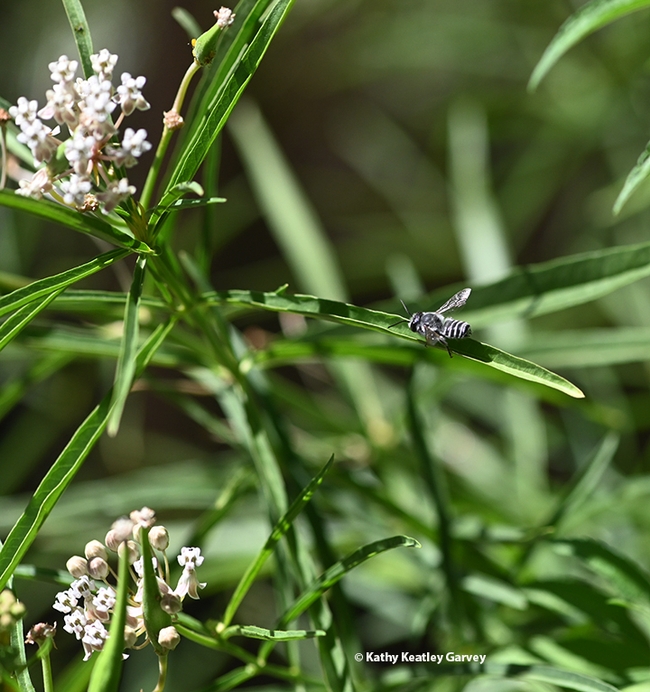
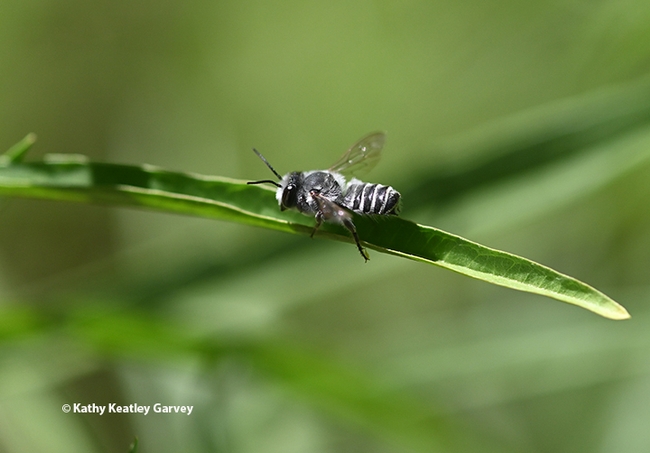
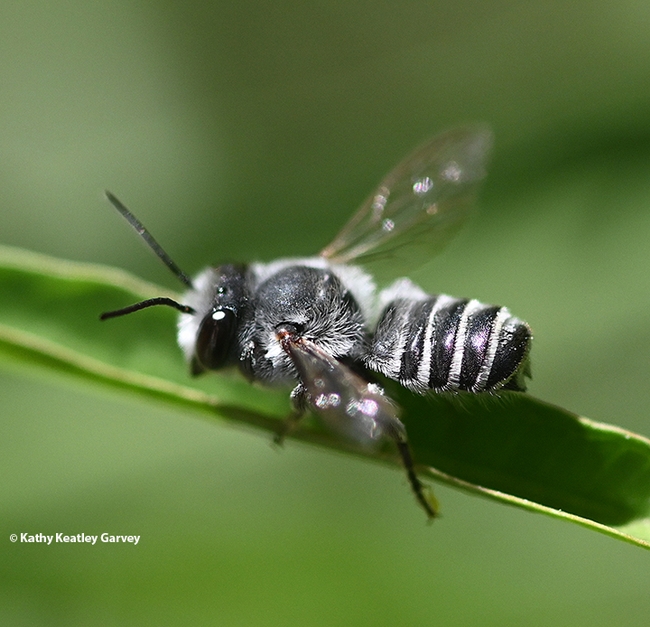
- Author: Kathy Keatley Garvey
Where's Waldo?
If you've ever looked at a “Where's Waldo” pictorial book and tried to spot a cartoon-like character wearing a red-and-white striped shirt, a bobbie hat, and glasses, you know it's not that easy. Many look-alikes or red herrings populate each page.
Such is the case when you're trying to find a camouflaged green praying mantis in green vegetation.
Where's Waldo? Or, where's Walda?
Our narrow-leafed milkweed, Asclepias fascicularis, is blooming well. A lone male leafcutter bee likes to hang out there, patrolling for females. And the oleander aphids like to hang out on the stems, sucking the plant juices.
Where are the monarchs, you ask?
They are not there. But something else is.
A green praying mantis, probably a female Stagmomantis limbata, emerges amid the green stems, seed pods and leaves, and crawls toward clusters of lavender-white flowers.
Meet Walda, a master of disguise, stealth and ambush.
And she is hungry.
She's looking at you. You're looking at her. It's a standoff as she “prays” for prey.
A bee touches down on the flowers. A leafcutter circles. A Gulf Fritillary glides by.
And Walda? She isn't much of a hunter today.

